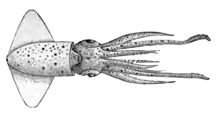- Sharpear Enope Squid
-
Sharpear Enope Squid 
Scientific classification Kingdom: Animalia Phylum: Mollusca Class: Cephalopoda Order: Teuthida Suborder: Oegopsina Family: Ancistrocheiridae
Pfeffer, 1912Genus: Ancistrocheirus
Gray, 1849Species: A. lesueurii Binomial name Ancistrocheirus lesueurii
(D'Orbigny, 1842)Synonyms - Onychoteuthis lesueurii
D'Orbigny, 1839 - Theliodioteuthis alessandrini
Vérany, 1851 - Ancistrocheirus alessandrinii
Vérany, 1851
The Sharpear Enope Squid (Ancistrocheirus lesueurii) is the only species in the genus Ancistrocheirus and family Ancistrocheiridae. With a mantle length of 25 cm, this moderately sized squid may be found throughout the tropical and subtropical oceans. They tend to be found at mesopelagic depths (200-1000 metres down).
Although only one species is recognized, some have suggested that more than one species may exist due to differences in the paralarval morphology. Paralarva is the first free-living stage for cephalopods.
Characteristics
The buccal crown of the Sharpear Enope Squid is heavily pigmented. The squid has no vesicles. There are hooks on all its arms. The suckers are absent from its manus and the squid's dactylus is reduced.
Photophores
There are photophores throughout its body. Large photophores are present on its head, funnel, base of arms, and tentacular stalk. Other photophores are present on the ventral surface of its mantle (usually 22), and there are numerous very small photophores on its head, funnel, base of arms II and tentacular stalk. Mature males will have large photophores on tips of arms IV opposite the mouth. Mature females have photophores on tips of its dorsal six arms. The number of large photopores on the Sharpear Enope Squid's mantle increases as it matures.
External links

This squid-related article is a stub. You can help Wikipedia by expanding it. - Onychoteuthis lesueurii
